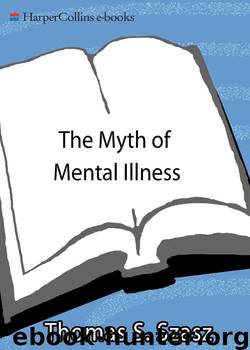The Myth of Mental Illness by Thomas S. Szasz

Author:Thomas S. Szasz
Language: eng
Format: mobi, epub
ISBN: 9780061771224
Publisher: HarperCollins US
Published: 2011-01-29T10:00:00+00:00
Dreaming and Hysteria as Hinting
The main advantage of hinting over more direct forms of communication is the protection it affords the speaker by enabling him to communicate without committing himself to what he says. Should the message be ill received, hinting leaves an escape route open. Indirect communications ensure the speaker that he will be held responsible only for the explicit meaning of his message. The overt message is thus a sort of vehicle for the covert message whose effect is feared.
Any reported dream may be regarded as an indirect communication or a hint. The manifest dream story is the overt message, while the latent dream thoughts constitute the covert message to which the dreamer alludes. This function of dreaming—and of dream communication—is best observed in the psychoanalytic situation, since in it the recounting of dreams is a fully acceptable form of social behavior. Analytic patients often produce dreams that refer to the analyst. Frequently, such dreams reveal that the analysand has some feelings or knowledge about the analyst which he finds distressing and is afraid to mention lest the analyst become angry. For example, the analyst might have been late or might have greeted the patient absentmindedly. The patient now finds himself in the difficult position of wanting to talk about this, to restore a more harmonious relationship with the analyst, yet being afraid to do so, lest by mentioning it he alienate the analyst still more. In this dilemma, the patient may resort to a dream communication. He might then report a dream alluding to the distressing occurrence, omitting perhaps the person of the analyst from it. This makes it possible for the patient to make the dangerous communication while keeping himself protected, since the analyst can interpret the dream in many different ways.16
If the analyst is able and willing to accept the patient’s reproach, he can so interpret the dream. Its covert communicative aim will then have been achieved: the embarrassing message was dispatched, the relationship to the analyst was not further endangered, and a more harmonious relationship between patient and analyst was established. On the other hand, if the analyst is upset, defensive, or otherwise unresponsive to the dream’s hidden message, he might interpret the communication in some other way. Although this is clearly less desirable for the course of the analysis, it is preferable for the patient to making an overt accusation and being reprimanded for it. The misunderstanding at least does not place an additional burden on an already disharmonious relationship.
The idea that dreams are allusions is not new, Freud himself having suggested it.17 However, he paid less attention to dream communications as interpersonal events than he did to the mental or intrapsychic aspects of dreaming. Ferenczi went further: in a short paper provocatively titled “To Whom Does One Relate One’s Dreams?”18 he dealt with dreams explicitly as indirect communications.
Just as any reported dream may be regarded as a hint, so may any reported hysterical symptom. Freud attributed the multiplicity of meanings characteristic of
Download
The Myth of Mental Illness by Thomas S. Szasz.epub
This site does not store any files on its server. We only index and link to content provided by other sites. Please contact the content providers to delete copyright contents if any and email us, we'll remove relevant links or contents immediately.
Periodization Training for Sports by Tudor Bompa(8171)
Why We Sleep: Unlocking the Power of Sleep and Dreams by Matthew Walker(6618)
Paper Towns by Green John(5092)
The Immortal Life of Henrietta Lacks by Rebecca Skloot(4527)
The Sports Rules Book by Human Kinetics(4297)
Dynamic Alignment Through Imagery by Eric Franklin(4118)
ACSM's Complete Guide to Fitness & Health by ACSM(3989)
Kaplan MCAT Organic Chemistry Review: Created for MCAT 2015 (Kaplan Test Prep) by Kaplan(3940)
Introduction to Kinesiology by Shirl J. Hoffman(3726)
Livewired by David Eagleman(3686)
The Death of the Heart by Elizabeth Bowen(3554)
The River of Consciousness by Oliver Sacks(3543)
Alchemy and Alchemists by C. J. S. Thompson(3451)
Bad Pharma by Ben Goldacre(3358)
Descartes' Error by Antonio Damasio(3231)
The Emperor of All Maladies: A Biography of Cancer by Siddhartha Mukherjee(3069)
The Gene: An Intimate History by Siddhartha Mukherjee(3050)
The Fate of Rome: Climate, Disease, and the End of an Empire (The Princeton History of the Ancient World) by Kyle Harper(3007)
Kaplan MCAT Behavioral Sciences Review: Created for MCAT 2015 (Kaplan Test Prep) by Kaplan(2941)
